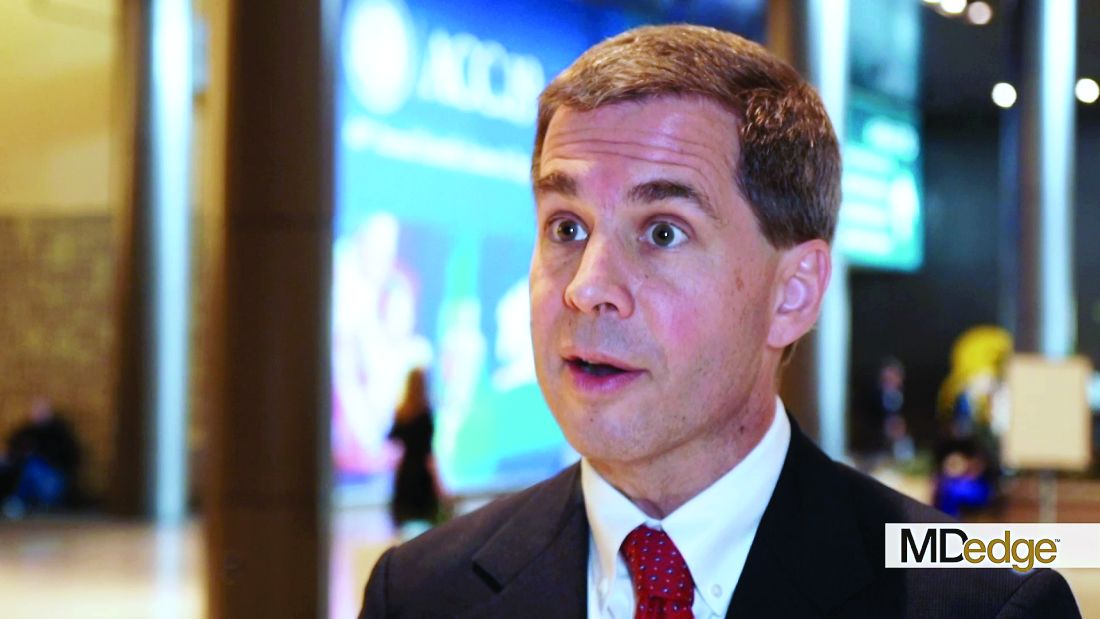User login
Intraoperative injection of calcium chloride into the four major atrial ganglionated plexi (GPs) reduced the incidence of early postoperative atrial fibrillation (POAF) in patients undergoing off-pump coronary artery bypass grafting (CABG) surgery, in a proof-of-concept study.
“[We] hypothesized that injecting [calcium chloride] into the major atrial GPs during isolated CABG can reduce the incidence of POAF by calcium-induced autonomic neurotoxicity,” wrote Huishan Wang, MD, of the General Hospital of Northern Theater Command in Shenyang, China, and colleagues. Their report was published in the Journal of the American College of Cardiology.
The single-center, sham-controlled, proof-of-concept study included 200 patients without a history of AF undergoing isolated, off-pump CABG surgery. Participants were randomized (1:1) to receive an injection of either 5% calcium chloride or 0.9% sodium chloride into the four major GPs during CABG.
Post surgery, patients were monitored for the occurrence of POAF using routine 12-lead ECG and 7-day continuous telemetry and Holter monitoring. The primary endpoint was the incidence of POAF lasting 30 seconds or longer through 7 days. Various secondary outcomes, including POAF burden and length of hospitalization, were also measured.
After analysis, the researchers found that 15 patients in the calcium chloride arm and 36 patients in the sodium chloride arm developed POAF during the first 7 days post CABG, corresponding to a POAF hazard reduction of 63% (hazard ratio, 0.37; 95% confidence interval, 0.21-0.64; P = .001) with no significant adverse effects observed among study patients.
The calcium chloride injection also resulted in reduced AF burden and lower rates of amiodarone and esmolol use to treat POAF; however, there was no difference in the length of hospitalization between the two groups. The incidences of nonsustained atrial tachyarrhythmia (less than 30 seconds) and atrial couplets were also significantly reduced in the calcium chloride group.
“We selected the 4 major atrial GPs as our targets because [of] their role in the initiation and maintenance of AF is more established than other cardiac neural plexi,” the researchers explained. “Interruption of the atrial neural network by Ca-mediated GP neurotoxicity may underlie the therapeutic effects.”
Is ‘nuisance’ arrhythmia worth targeting?
In an editorial accompanying the report, John H. Alexander, MD, MHS, wrote that intraoperative calcium chloride atrial ganglionic ablation can now be considered as an effective intervention to prevent POAF in patients undergoing cardiac surgery. “These investigators should be congratulated for studying post-operative atrial fibrillation in cardiac surgery,” he stated.
“However, this trial has two significant limitations. Firstly, it was conducted in a single center in a very homogeneous population; secondly, POAF, in and of itself, is largely a nuisance arrhythmia and hardly worth preventing, but is associated with a higher risk of other adverse outcomes,” Dr. Alexander, professor of medicine at Duke University, Durham, N.C., said in an interview.
“The unanswered question is whether preventing perioperative AF will prevent stroke, heart failure, and death,” he further explained. “Answering these questions would require a larger trial (or trials) with longer term (months to years) follow-up.”
Dr. Wang and colleagues acknowledged that the current study was underpowered for some secondary outcomes, such as length of hospitalization. They explained that a large sample size is needed to detect a difference in length of hospitalization, as well as other outcomes.
“Further studies are needed to confirm the safety and efficacy of calcium-induced atrial autonomic denervation in patients undergoing on-pump CABG and surgery for valvular heart disease,” they concluded.
The study was funded by the Provincial Key R & D Program in China. One author reported holding a U.S. patent related to the study. The remaining authors had no relevant relationships to disclose.
Intraoperative injection of calcium chloride into the four major atrial ganglionated plexi (GPs) reduced the incidence of early postoperative atrial fibrillation (POAF) in patients undergoing off-pump coronary artery bypass grafting (CABG) surgery, in a proof-of-concept study.
“[We] hypothesized that injecting [calcium chloride] into the major atrial GPs during isolated CABG can reduce the incidence of POAF by calcium-induced autonomic neurotoxicity,” wrote Huishan Wang, MD, of the General Hospital of Northern Theater Command in Shenyang, China, and colleagues. Their report was published in the Journal of the American College of Cardiology.
The single-center, sham-controlled, proof-of-concept study included 200 patients without a history of AF undergoing isolated, off-pump CABG surgery. Participants were randomized (1:1) to receive an injection of either 5% calcium chloride or 0.9% sodium chloride into the four major GPs during CABG.
Post surgery, patients were monitored for the occurrence of POAF using routine 12-lead ECG and 7-day continuous telemetry and Holter monitoring. The primary endpoint was the incidence of POAF lasting 30 seconds or longer through 7 days. Various secondary outcomes, including POAF burden and length of hospitalization, were also measured.
After analysis, the researchers found that 15 patients in the calcium chloride arm and 36 patients in the sodium chloride arm developed POAF during the first 7 days post CABG, corresponding to a POAF hazard reduction of 63% (hazard ratio, 0.37; 95% confidence interval, 0.21-0.64; P = .001) with no significant adverse effects observed among study patients.
The calcium chloride injection also resulted in reduced AF burden and lower rates of amiodarone and esmolol use to treat POAF; however, there was no difference in the length of hospitalization between the two groups. The incidences of nonsustained atrial tachyarrhythmia (less than 30 seconds) and atrial couplets were also significantly reduced in the calcium chloride group.
“We selected the 4 major atrial GPs as our targets because [of] their role in the initiation and maintenance of AF is more established than other cardiac neural plexi,” the researchers explained. “Interruption of the atrial neural network by Ca-mediated GP neurotoxicity may underlie the therapeutic effects.”
Is ‘nuisance’ arrhythmia worth targeting?
In an editorial accompanying the report, John H. Alexander, MD, MHS, wrote that intraoperative calcium chloride atrial ganglionic ablation can now be considered as an effective intervention to prevent POAF in patients undergoing cardiac surgery. “These investigators should be congratulated for studying post-operative atrial fibrillation in cardiac surgery,” he stated.
“However, this trial has two significant limitations. Firstly, it was conducted in a single center in a very homogeneous population; secondly, POAF, in and of itself, is largely a nuisance arrhythmia and hardly worth preventing, but is associated with a higher risk of other adverse outcomes,” Dr. Alexander, professor of medicine at Duke University, Durham, N.C., said in an interview.
“The unanswered question is whether preventing perioperative AF will prevent stroke, heart failure, and death,” he further explained. “Answering these questions would require a larger trial (or trials) with longer term (months to years) follow-up.”
Dr. Wang and colleagues acknowledged that the current study was underpowered for some secondary outcomes, such as length of hospitalization. They explained that a large sample size is needed to detect a difference in length of hospitalization, as well as other outcomes.
“Further studies are needed to confirm the safety and efficacy of calcium-induced atrial autonomic denervation in patients undergoing on-pump CABG and surgery for valvular heart disease,” they concluded.
The study was funded by the Provincial Key R & D Program in China. One author reported holding a U.S. patent related to the study. The remaining authors had no relevant relationships to disclose.
Intraoperative injection of calcium chloride into the four major atrial ganglionated plexi (GPs) reduced the incidence of early postoperative atrial fibrillation (POAF) in patients undergoing off-pump coronary artery bypass grafting (CABG) surgery, in a proof-of-concept study.
“[We] hypothesized that injecting [calcium chloride] into the major atrial GPs during isolated CABG can reduce the incidence of POAF by calcium-induced autonomic neurotoxicity,” wrote Huishan Wang, MD, of the General Hospital of Northern Theater Command in Shenyang, China, and colleagues. Their report was published in the Journal of the American College of Cardiology.
The single-center, sham-controlled, proof-of-concept study included 200 patients without a history of AF undergoing isolated, off-pump CABG surgery. Participants were randomized (1:1) to receive an injection of either 5% calcium chloride or 0.9% sodium chloride into the four major GPs during CABG.
Post surgery, patients were monitored for the occurrence of POAF using routine 12-lead ECG and 7-day continuous telemetry and Holter monitoring. The primary endpoint was the incidence of POAF lasting 30 seconds or longer through 7 days. Various secondary outcomes, including POAF burden and length of hospitalization, were also measured.
After analysis, the researchers found that 15 patients in the calcium chloride arm and 36 patients in the sodium chloride arm developed POAF during the first 7 days post CABG, corresponding to a POAF hazard reduction of 63% (hazard ratio, 0.37; 95% confidence interval, 0.21-0.64; P = .001) with no significant adverse effects observed among study patients.
The calcium chloride injection also resulted in reduced AF burden and lower rates of amiodarone and esmolol use to treat POAF; however, there was no difference in the length of hospitalization between the two groups. The incidences of nonsustained atrial tachyarrhythmia (less than 30 seconds) and atrial couplets were also significantly reduced in the calcium chloride group.
“We selected the 4 major atrial GPs as our targets because [of] their role in the initiation and maintenance of AF is more established than other cardiac neural plexi,” the researchers explained. “Interruption of the atrial neural network by Ca-mediated GP neurotoxicity may underlie the therapeutic effects.”
Is ‘nuisance’ arrhythmia worth targeting?
In an editorial accompanying the report, John H. Alexander, MD, MHS, wrote that intraoperative calcium chloride atrial ganglionic ablation can now be considered as an effective intervention to prevent POAF in patients undergoing cardiac surgery. “These investigators should be congratulated for studying post-operative atrial fibrillation in cardiac surgery,” he stated.
“However, this trial has two significant limitations. Firstly, it was conducted in a single center in a very homogeneous population; secondly, POAF, in and of itself, is largely a nuisance arrhythmia and hardly worth preventing, but is associated with a higher risk of other adverse outcomes,” Dr. Alexander, professor of medicine at Duke University, Durham, N.C., said in an interview.
“The unanswered question is whether preventing perioperative AF will prevent stroke, heart failure, and death,” he further explained. “Answering these questions would require a larger trial (or trials) with longer term (months to years) follow-up.”
Dr. Wang and colleagues acknowledged that the current study was underpowered for some secondary outcomes, such as length of hospitalization. They explained that a large sample size is needed to detect a difference in length of hospitalization, as well as other outcomes.
“Further studies are needed to confirm the safety and efficacy of calcium-induced atrial autonomic denervation in patients undergoing on-pump CABG and surgery for valvular heart disease,” they concluded.
The study was funded by the Provincial Key R & D Program in China. One author reported holding a U.S. patent related to the study. The remaining authors had no relevant relationships to disclose.
FROM THE JOURNAL OF THE AMERICAN COLLEGE OF CARDIOLOGY

